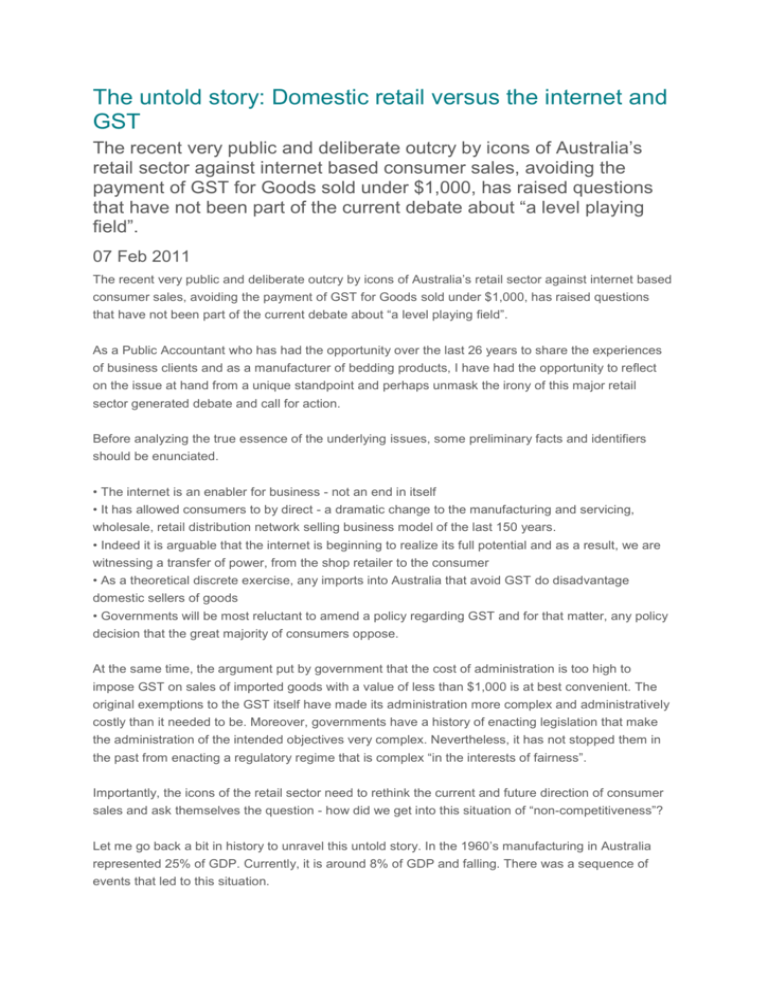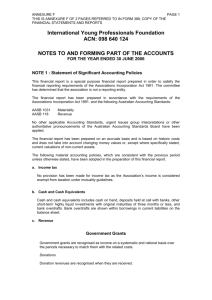The untold story: Domestic retail versus the internet and GST The
advertisement

The untold story: Domestic retail versus the internet and GST The recent very public and deliberate outcry by icons of Australia’s retail sector against internet based consumer sales, avoiding the payment of GST for Goods sold under $1,000, has raised questions that have not been part of the current debate about “a level playing field”. 07 Feb 2011 The recent very public and deliberate outcry by icons of Australia’s retail sector against internet based consumer sales, avoiding the payment of GST for Goods sold under $1,000, has raised questions that have not been part of the current debate about “a level playing field”. As a Public Accountant who has had the opportunity over the last 26 years to share the experiences of business clients and as a manufacturer of bedding products, I have had the opportunity to reflect on the issue at hand from a unique standpoint and perhaps unmask the irony of this major retail sector generated debate and call for action. Before analyzing the true essence of the underlying issues, some preliminary facts and identifiers should be enunciated. • The internet is an enabler for business - not an end in itself • It has allowed consumers to by direct - a dramatic change to the manufacturing and servicing, wholesale, retail distribution network selling business model of the last 150 years. • Indeed it is arguable that the internet is beginning to realize its full potential and as a result, we are witnessing a transfer of power, from the shop retailer to the consumer • As a theoretical discrete exercise, any imports into Australia that avoid GST do disadvantage domestic sellers of goods • Governments will be most reluctant to amend a policy regarding GST and for that matter, any policy decision that the great majority of consumers oppose. At the same time, the argument put by government that the cost of administration is too high to impose GST on sales of imported goods with a value of less than $1,000 is at best convenient. The original exemptions to the GST itself have made its administration more complex and administratively costly than it needed to be. Moreover, governments have a history of enacting legislation that make the administration of the intended objectives very complex. Nevertheless, it has not stopped them in the past from enacting a regulatory regime that is complex “in the interests of fairness”. Importantly, the icons of the retail sector need to rethink the current and future direction of consumer sales and ask themselves the question - how did we get into this situation of “non-competitiveness”? Let me go back a bit in history to unravel this untold story. In the 1960’s manufacturing in Australia represented 25% of GDP. Currently, it is around 8% of GDP and falling. There was a sequence of events that led to this situation. Australian governments embraced opening up Australian manufacturing to competition from imports by several measures including revaluing the Australian dollar by 25% (before the dollar was floated), removing or substantially reducing tariffs and eliminating import quotas. Economists argued that this would force manufacturers to innovate, consolidate (to obtain economies of scale) and provide long term benefits to consumers through price reductions. Further, the diminution of the production of locally made goods would be taken up by the growth in services to generate employment and that education would and should support the knowledge gap between unskilled labour (manufacturing) to skilled labour (services).When the Aussie dollar was floated in the 1980s it was seen to be a force of support for local manufacturers as a major devaluation of the dollar made imports more expensive and exports cheaper. The major retailers’ role in all of this upheaval has not been fully disclosed and debated. As imports became cheaper Australian manufacturers (AM’s) were at a major disadvantage. The pendulum swung way past the “competitive” point of even handedness and swung heavily in favour of local manufacturers closing down and becoming importers. So the committed local manufacturers went to the retailers (RS’s) for support and the conversation went something like this: “Mr. RS, I want to show you my range of goods that are really good quality and of course Australian made. Yes Mr. AM but your price is 15% dearer than you competitor. Yes I know Mr. RS but mine is Australian made and theirs is an imported product. Look Mr. AM, we have to make our 200% margin to allow us to offer 40% discounts at sale time and the consumer is driven by price. But Mr. RS surely you want to support Australian made. As the buyer for Mr. RS Mr. AM, I have to meet certain price points and margins and the consumer doesn’t care about Australian made.” With the passage of time, many retailers cut out the importer and went direct. I find it fascinating that the icons of retail in Australia are now on a major campaign to argue that by allowing direct imports by consumers under $1,000 GST free, “retail jobs will be lost”. When Australian manufacturers cried out for help from retailers to support Australian manufacturing and Australian jobs, it went on deaf ears. The fact is that clothing for example is at least 50% cheaper in the USA than in Australia and the cost of shipping is not expensive. Even if the GST component was imposed, it would not in my opinion have any material impact on these consumer direct sales. The untold story is that the failure of retailers to support local manufacturers has come to bite them back on their collective behinds because their support of Importers educated the public that buying imports is the norm and the promotion of Australian manufacturing has no place in consumerism and in their retail outlets. There are a number of other interesting related issues to this topic that are outside the scope of this paper including the importing of services, the resurrection of manufacturing and the high risk strategy of relying on the resources sector for economic stability and growth. Suffice to say, the internet revolution is only beginning to create dramatic changes as a result of its impact on the internationalization of the availability and distribution of goods and services in Australia to consumers. The question you have to ask is “Will I be ready to stay ahead of the game?” Written By David Mond, Managing Director - Recoveries Corp Why retailers are wrong about GST by Inside Retailing Online on January 04, 2011 Comments Retweet ( 3 votes, average: 3.67 out of 5 ) 21 Australia's biggest retailers are set to step up their campaign to force the Federal Government to drop the GST exemption on goods purchased from overseas websites that are worth less than $1000, with a new $200,000 advertising campaign that claims thousands of jobs are at stake. But SmartCompany editor James Thomson argues this is a futile campaign that will put consumers offside and fail to stop the growth in online retailing. Thomson offers five reasons the nation’s biggest retailers campaign will fail: 1. Cutting the threshold won't work Myer, Harvey Norman and David Jones presumably want the GST-exempt threshold removed entirely, but the noises coming from government suggest there is no way that's going to happen – probably the best they can hope for is a reduction from the current level of $1000. But research conducted by SmartCompany suggests that even drastically cutting the threshold in half would have a limited impact, as the most popular purchases from overseas websites – books, CDs and DVDs – are well under $100. 2. Online sales aren't that high As assistant treasurer Bill Shorten has been quick to point out, online retail sales are simply not high enough to pose the sort of threat the big retailers are claiming. Just three per cent of total retail sales are conducted online and at the most, half of these are made by overseas websites. "While this percentage is clearly growing, a bit of context is important. In the worst case, just 1.5 per cent of total retail sales are being made by overseas websites – hardly enough to cause the "reduction in hours and shifts for casual and part-time workers and ultimately cost Australian jobs in retail, manufacturing, logistics and related services" that the retailers' ads claim." 3. GST is not the reason people shop on overseas websites Suggestions that Australian consumers are drawn to overseas websites because it allows them to dodge the GST are "silly" says Thomson - as various commentators have pointed out, what a shopper saves on the GST is usually eaten up in shipping costs. "In reality, shoppers are turning to overseas sites to capitalise on cheaper prices (a particularly strong factor given the strength of the Australian dollar in recent months), better range and better customer service. Cutting the GST threshold won't change these trends." 4. Just because the big retailers have struggled with selling online, doesn't mean everyone else has Harvey Norman doesn't sell through its website. David Jones only relaunched its online store last November. Myer's online sales are a tiny percentage of their overall sales. "In other words, these are not companies that have spent time or money creating a globallycompetitive online presence. To complain that they are now losing sales to companies who have consistently shown innovation and leadership in the online retail sector looks like sour grapes, and it is," says Thomson. 5. Consumers won't stand for it Harvey Norman, Myer and David Jones would do well to remember who will actually be hit by a push to reduce or eliminate the GST threshold – their customers. "As we've argued above, a change to the GST threshold won't stop consumers shopping overseas. But if it was to happen, you can rest assured that these consumers will long remember the companies that forced the price of goods from overseas up – and let their wallets do the talking by turning away from these dinosaur retailers." RETAIL GST FUSS MISSES THE REAL CONCERNS AS retail king Gerry Harvey concedes defeat by the power of e-commerce, a newly formed coalition of retailer and wholesaler associations - the Fair Imports Alliance (FIA) – says the fuss over the GST threshold misses the more significant issue of systematic abuse of current regulations for imported goods. FIA joint spokesperson and Australian Retailers Association (ARA) executive director Russell Zimmerman says consumers exercising their right to purchase personal items from offshore websites is just part of the ‘new reality’ for retailers operating in a global retail environment. The real issue is about fixing loopholes in the system that allow imports on a much larger scale. “Even if the GST threshold for imported goods was lowered or abolished tomorrow, it still wouldn’t solve the long-term issue of individuals and businesses rorting the system to the detriment of Australian retailers and wholesalers,” says Zimmerman. “What requires serious Government consideration is how our current regulatory environment allows misuse of the system by businesses importing numerous packages under the GST threshold over a significant period and then opening temporary pop-up stores or selling the goods on e-bay GST free.” FIA joint spokesperson and Australian Sporting Goods Association (ASGA) executive director Brad Kitschke, agreed properly enforcing importation regulations and preventing manipulation of the system was a more significant issue than the level of the GST threshold. “This is why Minister for Home Affairs Brendan O’Connor’s customs compliance campaign, due to begin early this year, is so important. It will expose flaws in the system that enable legitimate Australian businesses to be undercut by those abusing current regulations,” says Kitschke. “Smart retailers are supportive of consumer choice and this debate shouldn’t be about punishing individuals who want to jump online and order goods from overseas for themselves or their families. All power to them – this is the sort of global environment in which retailers need to compete.” The FIA comprises the following organisations: Australian Retailers Association (ARA), Australian Sporting Goods Association (ASGA), Bicycle Industries Australia (BIA), Australian Toy Association (ATA), Photo Marketing Association (PMA), Australian Fishing Trade Association (AFTA), Australian Booksellers Association (ABA), Australian Music Association (AMA) and the Retail Cycle Traders Australian (RCTA). The bad news for the consumer led recovery is that The Australian Retailers Association’s (ARA) week-by-week tracking of retail trade during the Christmas period has found that the final week leading into Christmas Eve, more than 45% per cent of retailers were trading worse than the same time last year. Key points • Almost 42 per cent were trading above; • Over 45 per cent were trading below; • Over 12 per cent were trading the same as last year. Zimmerman says retailers who were hoping for a substantial last minute rush of Christmas shoppers were largely disappointed in the final days leading into Christmas. “ARA Christmas trade projections of $39.9 billion (modest 3.5 percent growth) look likely to be met although the Christmas trade started extremely slowly in November after the last interest rate hike forced many retailers into early sales mode,” he says. “As a result of this slower trade, we are already receiving reports that the post-Christmas sales period (26 December until mid January) including massive Boxing Day sales, has been very strong. Although only a small 3 percent growth is predicted, post Christmas sales nationally should hit $6.97 billion nationally. “Sales of seasonal products, including clothing and footwear, as well as small household appliances have seen strong sales. Products such as Christmas cards, wrapping paper, have seen savvy customers snapping up bargains. Many customers armed with Christmas gift cards are spending up on sale goods.” Harvey Norman Bundall franchisee Steve Cavalier would not weigh into the debate regarding Gerry Harvey’s comments regarding online shopping, but indicated that sales over the Christmas period were up on last year. “Sales have been very good, definitely up on last year,” he says. 2010/11 projections national totalled $6.97 billion. NSW - $2.23 billion, VIC - $1.74 billion, QLD - $1.37 billion, WA - $799 million, SA - $482 million, TAS $150 million, ACT - $129 million, NT - $71 million.






